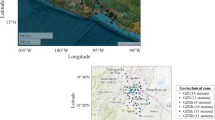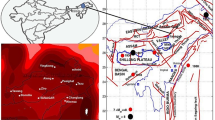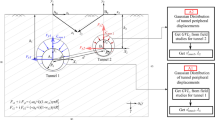Abstract
The strong motion displacement records available during an earthquake can be treated as the response of the earth as the a structural system to unknown forces acting at unknown locations. Thus, if the part of the earth participating in ground motion is modelled as a known finite elastic medium, one can attempt to model the source location and forces generated during an earthquake as an inverse problem in structural dynamics. Based on this analogy, a simple model for the basic earthquake source is proposed. The unknown source is assumed to be a sequence of impulses acting at locations yet to be found. These unknown impulses and their locations are found using the normal mode expansion along with a minimization of mean square error. The medium is assumed to be finite, elastic, homogeneous, layered and horizontal with a specific set of boundary conditions. Detailed results are obtained for Uttarkashi earthquake. The impulse locations exhibit a linear structure closely associated with the causative fault. The results obtained are shown to be in good agreement with reported values. The proposed engineering model is then used to simulate the acceleration time histories at a few recording stations. The earthquake source in terms of a sequence of impulses acting at different locations is applied on a 2D finite elastic medium and acceleration time histories are found using finite element methods. The synthetic accelerations obtained are in close match with the recorded accelerations.
Similar content being viewed by others
References
Chandrasekaran A R and Das J D 1995 Strong motion records from Uttarkashi earthquake,Mem. Geol. Soc. India,30 pp. 133–147
Ewing W M, Jardetzky W S and Press F 1957Elastic waves in Layered Media, (McGraw-Hill Book Company Inc.,)
Geological Survey of India 1992Uttarkashi Earthquake October, 20, 1991 (1992), Special Publication No. 30.
Iyengar R N and Iyengar K T S 1969 “A non-stationary random process model for earthquake accelerograms,”Bulletin of the Seismological Society of America,59 pp. 1163–1188
Iyengar R N and Rao P N 1975 Free vibration of an elastic medium;Bulletin of the Indian Society of Earthquake Technology,12(4) December 1975, pp. 147–154
Khattri K N 1993 An overview of seismicity of Himalaya, InEarthquake Hazard and Large Dams in the Himalaya, (ed) V K Gaur, New Delhi: INTACH
Khattri K N, Yu G, Anderson J G, Brune J N and Zeng Y 1994 Seismic hazard estimation using modelling of earthquake strong ground motions: a brief analysis of 1991 Uttarkashi earthquake, Himalaya and prognostication for a great earthquake in the region,Curr. Sci. 67(5), September, pp. 343–353
Kumar D Khattri K N Teotia S S and Rai S S 1999 Modelling of accelerograms of two Himalayan earthquakes using a novel semi-empirical method and estimation of accelerogram for a hypothetical great earthquake in the Himalaya;Curr: Sci. 76(6) 25 March 1999, pp. 819–830
NISA II 1994User's Manual, Engineering Mechanics Research Corporation, Troy, Michigan, USA, December 1994.
Shinozuka H and Sato Y 1967 Simulation of non-stationary random process;Journal of Engineering Mechanics Division ASCE,93(1), pp. 11–40
Yu G, Khattri K N, Anderson J G, Brune J N and Zeng Y 1995 Strong ground motion from the Uttarkashi, Himalaya, India, earthquake: Comparison of observations with synthetics using the composite source model;Bulletin of the Seismological Society of America,85(1), February, pp. 31–50
Author information
Authors and Affiliations
Rights and permissions
About this article
Cite this article
Iyengar, R.N., Agrawal, S.k. Earthquake source model using strong motion displacement as response of finite elastic media. J Earth Syst Sci 110, 9–23 (2001). https://doi.org/10.1007/BF02702226
Received:
Revised:
Issue Date:
DOI: https://doi.org/10.1007/BF02702226




